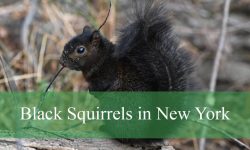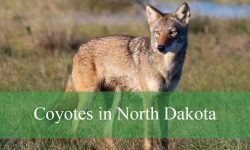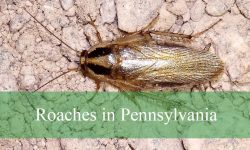A quiet walk through Kansas’s prairies, woodlands, or farmland often reveals the quick flash of a rabbit darting through the grass. These small, alert mammals are an essential part of the state’s ecosystem, providing food for hawks, owls, and coyotes while helping maintain the natural balance of vegetation across open fields and forest edges.
Kansas hosts several native rabbit species, each adapted to specific environments ranging from lush river valleys to arid plains. Their differences in size, fur color, and behavior reveal how they have evolved to thrive in varied landscapes.
In this detailed guide, you’ll learn about four types of wild rabbits in Kansas—including the common Eastern Cottontail, the aquatic Swamp Rabbit, the hardy Desert Cottontail, and the swift Black-tailed Jackrabbit. Each species plays a unique role in the natural world and offers fascinating insights for wildlife enthusiasts.
Common Types of Wild Rabbits Found in Kansas
Eastern Cottontail (Sylvilagus floridanus)
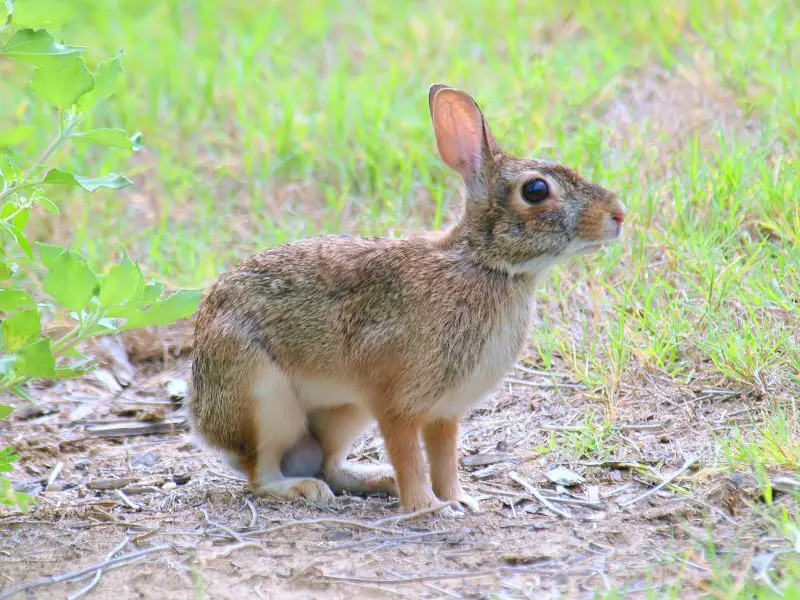
The Eastern Cottontail is the most widespread and familiar wild rabbit across Kansas, frequently seen in fields, parks, and backyards. It is characterized by a soft brownish-gray coat with a rusty hue on the nape of the neck and a white underside. Its short, rounded tail—white on the bottom—resembles a cotton ball, giving this species its common name. The fur color helps it blend seamlessly into grassy or brushy environments, providing natural camouflage from predators.
Adults typically measure 14 to 17 inches in length and weigh between 2 and 4 pounds, with females slightly larger than males. The large, upright ears serve both for detecting sound and dissipating body heat during warm Kansas summers. Their eyes are positioned wide apart on the head, offering a nearly 360-degree field of vision—an essential adaptation for spotting threats in open areas.
Eastern Cottontails are crepuscular, meaning they are most active during the early morning and evening. They spend their days hidden in thick vegetation, venturing out to feed on grasses, clover, bark, and even garden plants. When startled, they often freeze motionless, relying on stillness and coloration before suddenly darting away in a zigzag pattern to confuse predators.
The species breeds prolifically, with females capable of having three to seven litters per year, each containing four to seven young. Nests are shallow depressions lined with fur and grass, hidden in tall weeds or field edges. The young, called kits, grow quickly and leave the nest after only a few weeks.
Across Kansas, the Eastern Cottontail thrives in a range of environments—from the eastern woodlands and suburban areas to agricultural lands and prairie edges. Their adaptability to both rural and urban landscapes makes them the most abundant and frequently observed wild rabbit species in the state.
Swamp Rabbit (Sylvilagus aquaticus)
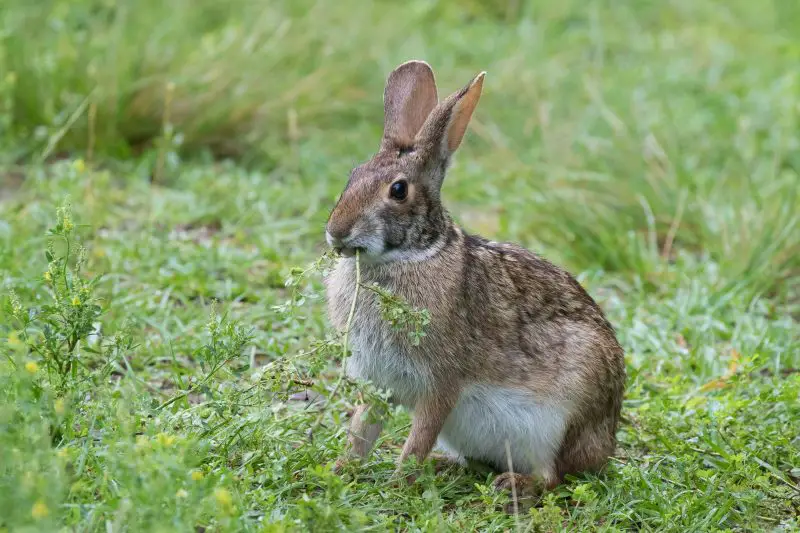
The Swamp Rabbit, sometimes called the Cane Cutter, is a larger and more aquatic species that inhabits southeastern Kansas, especially near rivers, creeks, and marshlands. It has a coarse, dark brown coat that appears almost black when wet, and its fur is thicker than that of the Eastern Cottontail. A faint cinnamon tint often appears on its sides, and its short tail shows a brownish top and white underside.
Adult Swamp Rabbits typically measure 16 to 20 inches long and weigh up to 5 or 6 pounds, making them the largest cottontail species in the United States. They have shorter ears relative to their size and robust hind legs designed for powerful leaps. Despite their weight, they move quickly through dense, wet vegetation and can swim with ease.
As their name suggests, these rabbits are semi-aquatic. They are strong swimmers and often escape predators by diving into water, where they can remain submerged except for their nose. Their diet includes grasses, sedges, young shoots, and aquatic plants. Swamp Rabbits are primarily nocturnal, venturing out at night to feed and rest during the day in dense cover.
Breeding season extends from late winter through summer, with females producing several litters per year. Each litter typically consists of three to four young, which are born in nests built above ground or within dense reeds. The survival rate of kits is lower than that of the Eastern Cottontail due to higher predation in wetland environments.
In Kansas, Swamp Rabbits are restricted to the southeastern counties, especially along the Verdigris, Neosho, and Spring Rivers. Their presence is a good indicator of healthy wetland ecosystems. Though less common than other rabbits in the state, their unique aquatic habits and larger size make them one of Kansas’s most fascinating native lagomorphs.
Desert Cottontail (Sylvilagus audubonii)
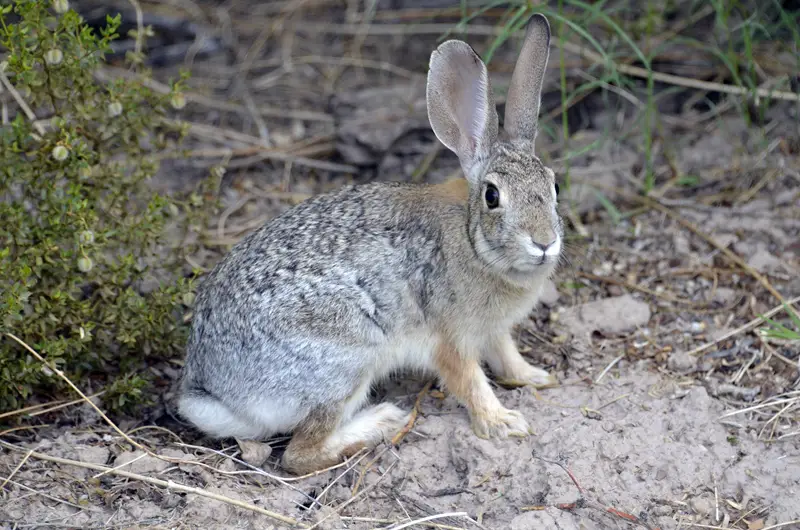
The Desert Cottontail is a pale, heat-tolerant species found mainly in western Kansas, where the climate is drier and vegetation more sparse. Its fur is a light grayish-tan, blending perfectly with the arid prairie soils. The underparts are white, and its tail—also white underneath—is smaller and less prominent than that of the Eastern Cottontail.
Adults usually reach 14 to 17 inches in length and weigh between 1.5 and 3 pounds. Their large, thin ears are a distinctive feature, helping them release heat and detect distant sounds in open landscapes. Desert Cottontails are leaner than other species, with longer legs suited for running swiftly across open ground.
They are most active during the cooler hours of dawn and dusk, spending the heat of the day sheltering beneath shrubs, rock piles, or abandoned burrows made by prairie dogs. Their diet consists of desert grasses, forbs, and the tender shoots of shrubs, which provide much of their moisture intake. They can survive long periods without free-standing water, deriving hydration from plants.
When threatened, the Desert Cottontail may freeze to avoid detection, then sprint in quick, erratic bursts reaching 20 mph. They are solitary animals except during the breeding season, which runs from spring through early fall. Females construct simple nests lined with fur and dried grass to shelter their young.
Within Kansas, the Desert Cottontail occupies semi-arid grasslands and sagebrush regions, particularly in the western and southwestern counties. They are well-suited to the state’s dry plains and represent the transition between the Great Plains fauna and that of the desert Southwest.
Black-tailed Jackrabbit (Lepus californicus)
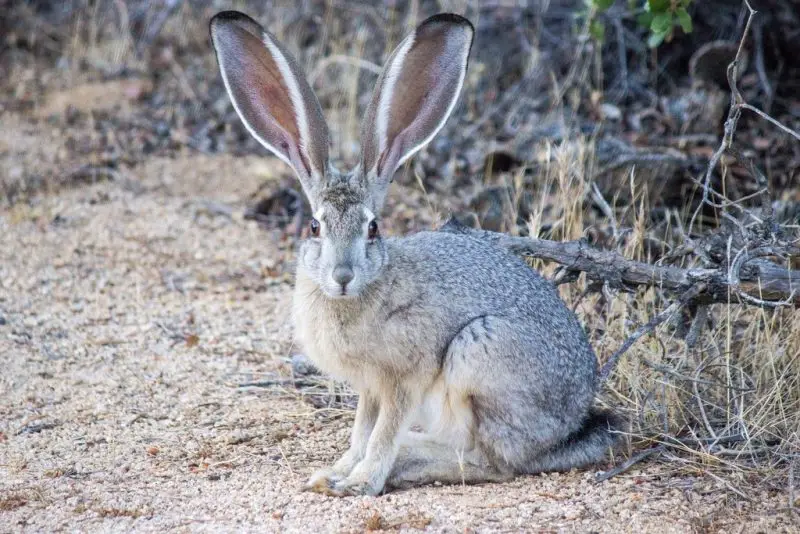
The Black-tailed Jackrabbit—though technically a hare, not a rabbit—is one of the most iconic mammals of western Kansas. It is immediately recognizable by its extraordinarily long black-tipped ears and slender build. The fur is grayish-brown, with lighter underparts and a distinctive black streak along the top of its tail, which is held upright when fleeing.
This species is significantly larger than true rabbits, measuring 18 to 24 inches long and weighing 4 to 6 pounds. Its hind legs are long and muscular, built for speed and endurance. The jackrabbit’s large ears not only aid in acute hearing but also help regulate body temperature in the hot, open plains where it lives.
Unlike cottontails, jackrabbits do not dig burrows. They rely on shallow depressions in the ground called “forms,” usually located under shrubs or clumps of grass. They are primarily nocturnal, feeding on grasses, sagebrush, and desert plants during the night. Their eyesight is exceptional, capable of detecting motion over long distances—an essential trait in open terrain.
When startled, a jackrabbit can leap up to 20 feet in a single bound and reach speeds exceeding 35 mph, zigzagging across the plains to evade predators like coyotes and hawks. During the breeding season, males engage in energetic chases and boxing matches as part of their courtship behavior.
In Kansas, Black-tailed Jackrabbits are common in the western half of the state, especially in open prairies, agricultural fields, and rangelands. Populations fluctuate with rainfall and vegetation cycles—booming in wet years and declining during droughts. Their agility, endurance, and adaptability make them one of Kansas’s most remarkable and resilient wild lagomorphs.
How to Identify Wild Rabbits in Kansas
Identifying wild rabbits in Kansas requires a careful look at physical traits, behavior, and habitat preferences. The most reliable features to observe include body size, ear length, fur color, tail shape, and movement patterns. The Eastern Cottontail is the easiest to recognize, with its compact, rounded body and bright white tail that flashes as it runs.
In contrast, the Desert Cottontail is slimmer, has paler grayish-tan fur, and longer ears adapted to Kansas’s hot, dry western plains. The Swamp Rabbit appears bulkier and darker, often seen near water sources, while the Black-tailed Jackrabbit—actually a hare—has very long black-tipped ears and long limbs built for speed.
The size and ear structure are particularly useful for field identification. Cottontails generally measure between 14 and 17 inches, with proportionate bodies and short tails. The jackrabbit, however, can reach up to 24 inches in length, making it the largest of Kansas’s wild rabbits. Its enormous ears and elongated hind legs immediately set it apart. These long ears also help regulate body temperature and detect faint sounds, making the jackrabbit well-suited to open prairie environments where sound travels far.
Tracks and droppings provide additional identification clues. Cottontail tracks show two small front paw prints side by side and two larger hind prints slightly ahead, indicating short hops. In contrast, jackrabbits leave more widely spaced hind prints due to their long, bounding leaps. Their droppings are also slightly larger and more oval than those of cottontails. Observing these subtle differences on trails or near feeding areas can confirm which species is present without direct sighting.
Finally, habitat type offers strong hints. Eastern Cottontails prefer woodland edges, brush piles, suburban lawns, and farmlands in eastern and central Kansas. Desert Cottontails and Jackrabbits dominate the open, dry rangelands of western Kansas, where sparse shrubs and grasses provide limited cover. Swamp Rabbits inhabit dense vegetation along rivers, creeks, and wetlands in the southeast. Paying attention to location and environment—along with size, coloration, and behavior—makes it easier to accurately identify Kansas’s four wild rabbit species.
Tips for Observing Wild Rabbits Safely
Watching wild rabbits in Kansas can be an enjoyable and educational experience, but it requires patience, respect, and a quiet approach. Rabbits are naturally cautious animals with excellent hearing and eyesight, allowing them to detect movement or sound long before a human can get close. Move slowly and avoid sudden gestures, as even the rustle of clothing can cause them to flee.
The best times for observation are early morning and late evening, when light levels are low and rabbits emerge to feed in open areas. During these periods, you’re more likely to see them foraging, grooming, or playfully interacting before retreating to cover as daylight strengthens.
When observing, keep a safe and respectful distance—use binoculars or a telephoto camera lens instead of trying to approach. Getting too close can stress the animal or disrupt its natural behavior. If you happen upon a nest or young kits, do not touch or move them. The mother is usually nearby, and human scent may attract predators or cause her to abandon the nest.
Likewise, never feed wild rabbits. Supplemental feeding can make them dependent on humans and disrupt their natural diet of grasses, herbs, and bark. For those exploring Kansas’s grasslands, woodlands, or farmlands, consider walking slowly along field edges or near brushy cover. Rabbits often remain still, blending into their surroundings until they feel directly threatened.
Look for slight movements of ears or the flick of a white tail among tall grasses. Many observers are surprised by how close rabbits can be without being noticed—sometimes only a few feet away, hidden in plain sight. Observing quietly at a distance allows them to behave naturally, offering a more authentic glimpse of their foraging and survival instincts.
When photographing or studying rabbits, maintain minimal disturbance. Use natural cover such as trees or shrubs to conceal your presence and avoid loud noises or artificial lights. By respecting their space and routines, wildlife watchers help ensure that Kansas’s wild rabbits continue to thrive in their natural habitats for generations to come.
FAQs about Wild Rabbits in Kansas
What is the most common rabbit species in Kansas?
The Eastern Cottontail (Sylvilagus floridanus) is the most common and widespread rabbit in Kansas. It thrives in a variety of habitats such as grasslands, wooded edges, and suburban yards. Its adaptability to both rural and urban areas allows it to maintain a stable population across nearly every county in the state.
Do wild rabbits in Kansas hibernate during winter?
No, wild rabbits do not hibernate. Throughout winter, they remain active and rely on thicker fur for insulation. During cold months, they spend more time in brush piles, under shrubs, or in burrows abandoned by other animals to stay warm and safe from predators. Their diet also shifts to twigs, bark, and dried grasses when green vegetation is scarce.
Are jackrabbits and rabbits the same animal?
Although both belong to the order Lagomorpha, jackrabbits are actually hares, not true rabbits. Jackrabbits, like the Black-tailed Jackrabbit (Lepus californicus) found in western Kansas, are larger, have longer ears, and give birth to fully furred young that can move shortly after birth. Rabbits, on the other hand, have smaller ears and give birth to blind, hairless kits that require nesting care.
Where can I see wild rabbits in Kansas?
Wild rabbits are found throughout Kansas in parks, prairies, farmlands, and forest edges. The best observation times are early morning and late evening when they feed and are most active. Eastern Cottontails are common near human settlements, while Desert Cottontails and Jackrabbits are more frequently seen in the western plains and arid grasslands.
Are wild rabbits protected in Kansas?
Yes, but with regulations. Wild rabbit populations in Kansas are monitored and managed by the Kansas Department of Wildlife and Parks (KDWP). Hunting is permitted in designated seasons to maintain ecological balance and prevent overpopulation. These laws ensure the species’ long-term sustainability while allowing responsible wildlife recreation.
What do wild rabbits eat in Kansas?
Wild rabbits are herbivores, feeding mainly on grasses, clover, wildflowers, bark, and tender shoots. During summer, they prefer green vegetation and garden plants, while in winter they rely on woody plants and dried stems. Their diet plays a key role in shaping plant growth across Kansas ecosystems.
Are wild rabbits active during the day or night?
Most wild rabbits in Kansas are crepuscular, meaning they are active around dawn and dusk. This behavior helps them avoid predators during peak daylight hours while allowing them to forage safely when temperatures are cooler. However, they may also feed at night, especially in areas with minimal human disturbance.
Can I keep a wild rabbit as a pet?
It’s not recommended and often illegal to keep wild rabbits as pets in Kansas. Wild rabbits are naturally shy and easily stressed by captivity. They also require specialized diets and care. If you find an injured or orphaned rabbit, contact a licensed wildlife rehabilitator rather than trying to care for it yourself.

